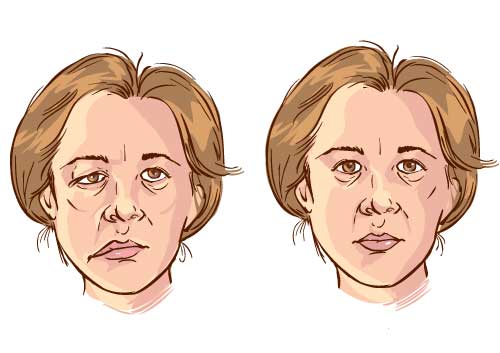Are you losing control of your facial muscles? The problem might be Bell’s palsy. This unusual condition causes a sudden, usually temporary weakness in your face that can give half of it a distinctive “drooping” appearance. About one person in 5,000 develops Bell’s palsy each year, and doctors still have questions about why it occurs. What causes Bell’s palsy and are there ways to treat it naturally?
Understanding the details behind the disease will help you answer these questions.
What is Bell’s Palsy?
Also known as facial palsy, Bell’s palsy is a condition that weakens or paralyzes your facial muscles, often on only one side of the face. Problems with the nerve that controls these muscles trigger the symptoms, and it often leads to secondary ones like excess drooling or tear production. Only rarely will the paralysis affect both sides of your face at once.
Many people confuse these symptoms with having a stroke, but one clue that the condition is Bell’s instead is that the paralysis will be limited to only your face. This “face freezing” is often worst in the mornings.
While Bell’s palsy is possible at any age, the situation is most common in people between 16 and 60. Its symptoms are usually temporary, but it’s critical that you seek treatment early to improve your odds of a making a full recovery.
What Causes Bell’s Palsy?
Doctor’s don’t always agree about what causes Bell’s palsy, but most believe that an already present virus typically triggers the condition. You might be aware that you already have one of these viruses from an earlier infection, or you might not have any concept it is there.
Examples of viruses that potentially lead to Bell’s include the following:
- Herpes simplex (cold sores and genital herpes)
- HIV (autoimmune disease)
- Sarcoidosis (organ inflammation)
- Herpes zoster (chickenpox and shingles)
- Lyme disease (bacterial infection from ticks)
- Adenovirus (respiratory illnesses)
- Rubella (German measles)
- Influenza B (the common flu)
- Coxsackievirus (hand-foot-and-mouth disease)
While your body can typically suppress these viruses, they are opportunists that can make their move when your system is stressed physically, emotionally, or both. This is because stress affects the functioning of your immune system and allows viruses to potentially gain a foothold where they might otherwise be fought off.
When one of these viruses attacks the facial nerve known as the 7th cranial, it begins to swell and potentially becomes compressed within the narrow Fallopian canal of the skull where it’s located. You have a 7th cranial nerve on either side of your face, and together they control most of the muscle movement for your face and ears. Compression like this can damage the protective covering of the nerve, causing it to malfunction by triggering twitching or facial paralysis. Both nerves are rarely affected at the same time, which is why the condition typically affects only half your face.
Who is Most at Risk of Bell’s Palsy?
While almost anyone has the possibility of contracting Bell’s palsy, the condition is most prevalent in specific populations, including:
- Pregnant women (especially those in the third trimester or after the first week of giving birth)
- Diabetics
- Those with an upper respiratory infection (like a cold)
There are known links between migraines and Bell’s palsy, and a 2015 study found that those who experienced regular headaches were at a higher risk of developing the condition.
While reoccurring instances of facial paralysis are rare, there is some evidence that family history has a role in who develops Bell’s, showing that the condition might have a genetic component. Interestingly, men and women tend to develop it at equal rates.
Signs and Symptoms of Bell’s Palsy
Have you experienced Bell’s Palsy before? Having any of the following symptoms is evidence that you have.
- Pain around the jaw or behind one ear
- The rapid development of facial weakness on one side of your face
- Visible facial drooping that makes smiling and blinking difficult
- Uncontrollable drooling and/or tear production
- Heightened sensitivity to sound in one ear
- Less taste sensitivity
- Prolonged headaches
- Dry eyes and other eye irritation
Consequences of Bell’s Palsy
Mild cases of Bell’s palsy will typically resolve themselves within a month. Severe cases, in contrast, can be hard to treat. They may potentially lead to lasting facial nerve damage, abnormal growths of nerve fibers that trigger involuntary neural contractions, or even partial or complete blindness due to the cornea drying out or becoming scratched because the eyelid isn’t covering it.
For these reasons, it’s vital that you seek out medical advice if you believe you have Bell’s palsy so that a doctor can diagnose the condition before it causes permanent damage.
Diagnosing Bell’s Palsy
While no specific tests exist for diagnosing Bell’s palsy, there are steps your doctor can take to determine whether you have it. The first step in the diagnostic process is a physical examination where you will be asked to manipulate your facial muscles by blinking, frowning, raising your eyebrows, and other expressions.

Because other health problems can cause facial paralysis, (like strokes, tumor growth, and infections), your doctor might recommend additional tests to narrow down the diagnosis. This may include an electromyography (EMG) to confirm whether nerve damage is present and to gauge its severity. Magnetic resonance imaging (MRI) scans are also a way to determine whether a tumor or skull fracture is putting pressure on the 7th cranial nerve.
Five Standard Treatment Options for Bell’s Palsy
Once it’s clear that the cause of your symptoms is Bell’s palsy, there are steps that your doctor will take to restore your face to better functioning. While there isn’t one treatment for Bell’s that works for everyone, you have several options for managing the symptoms to prevent permanent damage from occurring.
Below are some of the most common Bell’s palsy treatment options that your doctor may recommend.
1. Prednisolone Hormone Treatment (Corticosteroids)
You can speed up the recovery of Bell’s palsy by treating it with a hormone known as prednisolone. This inflammation reducer eliminates swelling in the 7th cranial nerve, which can prevent the irritation that eventually triggers paralysis. Research shows that taking corticosteroids within 72 hours of your symptoms showing up will dramatically reduce the severity of Bell’s for the next year.
2. Antiviral drugs
As the evidence is mixed that antivirals can treat Bell’s palsy effectively, some experts believe that this process isn’t worthwhile. Nonetheless, adding valacyclovir (Valtrex) to a steroid treatment seems to be beneficial for some people for reducing inflammation and treating the condition, so it’s often recommended.
3. Over-the-Counter Pain Medication
If Bell’s palsy paralysis is causing you pain, aspirin, ibuprofen, and Tylenol can provide you with relief, and they might temporarily relieve the pain.
4. Surgery
In extreme cases, undergoing surgery to widen the bony neural pathway that the seventh cranial nerve resides in can relieve the built-up pressure that’s on it. However, this surgery is rarely recommended anymore because it can potentially cause permanent facial nerve injuries and hearing loss.
5. Plastic Surgery
If the side effects of Bell’s palsy become permanent, it’s possible to undergo plastic surgery to improve the symmetry of your face. While this can restore appearances, it doesn’t cure the underlying nerve problem and won’t improve your muscle functioning. Botox is also an effective way to (temporarily) relax tight facial muscles to reduce Bell’s palsy contractions.
The Best Natural Treatment For Bell’s Palsy
If you’re looking for a non-invasive strategy for treating Bell’s palsy, here are the top three supplements I recommend. They are taken together. I have used this triple treatment in my practice for over 10 years with great success:
1. Inflamments
Designed to reduce the inflammation and nerve swelling that leads to Bell’s palsy and other inflammatory conditions, Inflamments is a natural supplement that balances your inflammatory response. Each natural vegetable cellulose capsule contains turmeric, skullkap root extract, and bee pollen to act as anti-inflammatory, antioxidant, and immune-enhancing agents.
Directions: take three capsules twice daily with food for four weeks.
2. Foundation Vitamin Formula
This professional grade daily vitamin and mineral formula will provide your body with a full spectrum of readily absorbable vitamins and minerals, including an optimal 2:1 balance of magnesium to calcium. Foundation Vitamin Formula also contains complete spectrum B vitamins to boost energy levels and reduce stress, and vitamin E to limit the damage of free radicals. This complete multivitamin helps keep you in optimal health, and boosts your immune system to fight Bell’s Palsy.
Directions: Take three tablets once a day with food.
3. Vitamin-D3 5,000
Maintaining the right levels of vitamin D3 is critical for good health, but few of us are getting as much as we should be. Taking a Vitamin-D3 5,000 supplement will boost your immune system and help the liver produce glutathione, a powerful antioxidant for detoxifying your body. As it’s essential for numerous metabolic processes for physical functioning, maintaining adequate levels of vitamin D3 boosts the immune system to fight Bell’s Palsy and help keep it away.
Directions: Take one capsule daily with food.
After the initial four week triple treatment, I recommend taking Foundation Vitamin Formula along with Vitamin D3 5,000 as part of your daily health regimen to keep your immune system optimized. This reduces your body’s risk of becoming vulnerable to a virus that might trigger Bell’s palsy.
Keep in mind that all supplements are not created equal. Store-bought brands can vary considerably in their quality, which is why I recommend that you choose Diamond Nutritionals’ products instead. These ultra-high-grade professional supplements are exclusively made in America and comply with the highest standards possible.
Four Lifestyle Treatment Options for Bell’s Palsy
If Bell’s palsy is a reoccurring concern for you, you might need to moderate its side effects through your lifestyle or with alternative treatment strategies. Some that show promise are below.
1. Protect Your Eyes from Dryness
Dry eyes are a common symptom of Bell’s palsy because the facial paralysis prevents you from closing your eyelids correctly. You can manage these symptoms by using eye drops or other lubricants to keep your cornea moist, so long-term damage doesn’t occur. You can also coat your eyes with an ointment at night, and wearing goggles or an eye patch will prevent the eye from getting scratched.
2. Physical Therapy
The paralysis caused by Bell’s palsy can shrink and shorten your facial muscles, occasionally causing permanent contractions. For this reason, it’s smart to work with a physical therapist who can teach you how to stretch your face to combat the symptoms. Exercising your facial muscles can relax them and reduce inflammation, so regularly tightening and loosening the muscles around your eyes and face can strengthen them and reduce paralysis.
Another physical therapy option is mime therapy, which emphasizes a wide range of facial exercises to strengthen your muscles, develop better coordination, and restore yourself to a complete range of motion.
3. Acupuncture
There is evidence that inserting thin needles into specific pressure points within the skin can relieve pain, reduce inflammation, and possibly counteract paralysis. This makes acupuncture a potentially beneficial alternative strategy for treating Bell’s palsy naturally.
4. Biofeedback Training
Your thoughts often have a profound impact on your body, so learning how to control them through biofeedback training can improve your control over your facial muscles to keep Bell’s palsy symptoms in check. Biofeedback training can reduce the severity of migraines, high blood pressure, and inflammation as well.
Long-Term Prognosis for Bell’s Palsy
Bell’s palsy might be a pain to deal with, but for most people, the condition is only temporary. Symptoms of paralysis and inflammation tend to dissipate after a few weeks, and most people make a complete recovery within six months.
That being said, seeking treatment is a smart solution if you want to recover from the symptoms faster. By taking the appropriate steps to get the condition under control, you’ll likely recover from your bout of Bell’s palsy without suffering any long-term side effects.
My preferred treatment strategy is to take Diamond Nutritionals’ Bell’s Palsy Triple Treatment: Inflamments, Foundation Vitamin Formula, and Vitamin-D3 5,000. These products will provide your body with what it needs to heal itself, boost the immune system, and reduce inflammation so that you can get to the root problem of Bell’s palsy without merely treating the symptoms.
No matter what, it’s always best to call your doctor right away if you start to notice the signs of Bell’s palsy. The faster you seek treatment, the sooner you can restore your face to normal functioning.








